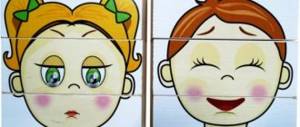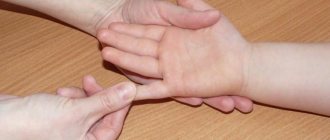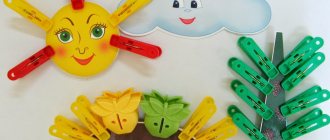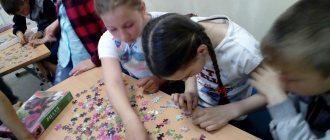“Mind at your fingertips” - a master class for specialists and teachers of preschool educational institutions
Compiled by: Music director of MBDOU “Kindergarten No. 4 “Teremok”, Novopavlovsk Kotova L.S.
Purpose: To clarify teachers’ ideas about the development of fine motor skills in early and senior preschool age.
Objectives: To convey to educators the importance of developing fine motor skills and help them master games and exercises using non-standard equipment. Convey work experience by directly commenting on the sequence of actions, methods and techniques.
Good afternoon, dear colleagues.
I would like to start our master class with the words of teacher V.A. Sukhomlinsky, who said that... “The child’s mind is at his fingertips.” Development and education cannot be given or imparted to any person. Anyone who wants to join them must achieve this through their own activity...
Let's join and comprehend together.
You need to start working on developing fine motor skills from a very early age. Already an infant can massage his fingers, thereby influencing the active points associated with the cerebral cortex. In early and early preschool age, you need to perform simple exercises, accompanied by a poetic text, and do not forget about developing basic self-care skills: buttoning and unbuttoning buttons, tying shoelaces, etc. And, of course, in older preschool age, work on developing fine motor skills and coordination hand movements should become an important part of preparation for school.
Currently, the full development of children from preschool age is becoming an urgent problem. Therefore, one of the indicators and conditions for a child’s good physical and neuropsychic development is the development of fine finger motor skills.
Today at the master class I would like to share with you my knowledge and skills in the field of development of fine motor skills in children and the possibility of its use in preschool educational institutions. The proposed non-standard equipment contributes not only to the development of the child’s fine motor skills, but also to imaginative thinking, perception, and coordination of movements in general. In order for a child to develop safely and actively, so that speech is correct, what is the secret? It turns out that it's all about the fingers, or rather, well-developed fine motor skills. The thing is that in the human brain the centers responsible for speech and finger movement are located very close. In other words, if the development of fingers lags behind, then speech development is also delayed. Typically, a child who has a high level of development of fine motor skills is able to reason logically, his memory, attention, and coherent speech are sufficiently developed. Those. I would like to draw your attention once again to ensure that our children are active, talkative, and smart - we must develop their fine motor skills.
In the process of games and exercises for the development of fine motor skills in children, attention, memory, auditory and visual perception are improved, perseverance is developed, and play and educational and practical activities are formed.
When conducting finger games, you need to train the child’s hand gently, but quite energetically; Squeeze your fingers vigorously too. Humming or speaking - rhythmically. You need to move your arms and fingers in time with the words. This will ensure the maximum effect of the classes, and as a result, clear coordination between the speech and motor centers, which is very useful for speech development.
The poems accompanying the exercises are the basis on which the sense of rhythm is formed and improved. They learn to hear rhyme, stress, and divide words into syllables.
A sense of rhythm is also important when learning to write (to develop smooth handwriting), for memorizing poetry, and to prevent writing disorders (missing vowels).
I bring to your attention games for the development of fine motor skills that can be practiced both in kindergarten and at home.
Take a bright tray.
Sprinkle any small grains onto a tray in a thin, even layer. Run your baby's finger over the rump. You will get a bright contrasting line. Let your child draw a few chaotic lines himself. Then try to draw some objects together (fence, rain, waves), letters, etc.
Choose buttons of different colors and sizes.
First, lay out the drawing yourself, then ask your child to do the same on his own. After the child learns to complete the task without your help, invite him to come up with his own versions of the drawings. You can use a button mosaic to make a tumbler, a butterfly, a snowman, balls, beads, etc.
Offer your child a round hair brush.
The child rolls the brush between his palms, saying:
“Pine, fir, and Christmas trees have very sharp needles. But the juniper will prick you even more powerfully than the spruce tree.”
Take a sink grate (usually it consists of many squares).
The child walks with his index and middle fingers, like legs, along these cells, trying to take steps on each stressed syllable. You can “walk” alternately with one hand and then with the other, or you can do it with both at the same time, saying:
“We wandered around the zoo, approached each cage and looked at everyone in a row: bear cubs, wolf cubs, beaver cubs.”
Pour 1 kg of peas or beans into a cup.
The child puts his hands in there and imitates kneading dough, saying:
“Knead, knead the dough, There is room in the oven. There will be buns and rolls coming out of the oven.”
You can use dry peas. The child transfers the peas one by one to another mug. First with one hand, then with both hands at the same time, alternately with the thumb and middle finger, thumb and ring finger, thumb and little finger.
"Ski relay"
We place two caps from plastic bottles on the table with the threads facing up. These are “skis”. The index and middle fingers stand in them like feet. We move on “skis”, taking one step for each stressed syllable:
“We go skiing, we rush down the mountain, We love the fun of cold winter.”
"Crocodile"
Using a clothespin (check on your fingers that it is not too tight), we alternately “bite” the nail phalanges (from the index to the little finger and back) on the stressed syllables of the verse:
“The silly kitten bites hard, He thinks it’s not a finger, but a mouse. (Change of hands.) BUT I’m playing with you, baby, And if you bite, I’ll tell you: “Shoo!”
You can take a clothesline (as thick as a child’s little finger) and tie 12 knots on it, turning the knots with your fingers, and for each knot name the month of the year in order. You can make similar devices from beads, buttons, etc.
Roll the walnut between your palms and say:
“I roll my nut so that it becomes rounder than everyone else.”
Drawing on semolina scattered on a tray.
We draw the sun, a circle, a path. To make the path different, first draw it with your thumb. Index finger, little finger.
Sort beans, peas, nuts.
You need to divide the contents of the plate into 3 mugs.
Laying out the outlines of objects with beans.
Take velvet paper and draw beans on it. We take beans from the mug.
Laying out the outlines of objects with thread, i.e. draw with thread.
It could be the sun, a tree, a number, a letter, etc.
Let's take a pea - I was bored at home alone, I took out a handful of peas. Before you start playing, you need to tell your finger, Finger, finger, my good one, You press the peas to the table, Twist and roll, And pass it on to someone else! (We pass it on.)
To develop tactile sensations, you can sew such bags, filling them with cereals, beans, cotton wool, etc. While fingering the bag, the baby massages his own fingers. Beads. Stringing pasta on a string, string, drying, etc. is good for developing a child’s hand.
Aqua gymnastics.
It's no secret that young children love playing with water. The essence of the method is as follows. Pour some water into a bowl, the water should be at a comfortable temperature, put any available materials at the bottom of the bowl - buttons of different shapes, sizes and colors, pebbles, shells, Kinder surprise toys, etc.. And then, including our imagination, fingers turn into octopuses, little men, and fish that “travel” along the seabed or find mysterious treasures. There is no limit to imagination here.
Nitcography is the laying out of patterns or geometric shapes from woolen or canvas threads of different thicknesses and lengths on velvet paper.
I will end my speech with these words - spend more time communicating with your baby, play with him, talk, devote a free minute to learning a new finger game, draw more, design - because you and I already know - “A child’s mind is at his fingertips” .
Development of fine motor skills, speech and thinking of a child.
It has already become a classic statement that the development of the hand helps the speech development of a preschool child and develops thinking. And all teachers and speech therapists know the words of M.M. Koltsova “There is every reason to consider the hand as an organ of speech - the same as the articulatory apparatus. From this point of view, the projection of the hand is another speech area of the brain.” This position entered pedagogy in the 70s of the 20th century and is justified both by the results of an experiment with children and by the anatomy of the brain (Broca’s speech motor center and the center that controls finger motor skills are located nearby).
But we have always met and still meet families in which they work a lot with their children in developing fine motor skills, buy special toys and aids (laces, sorters, beads), but the result is not pleasing, and for some reason there is no shift in the development of speech and thinking.
And there are other families where they don’t seem to be specifically involved in developing fine motor skills and are not doing anything, the child just sculpts, draws, plays, helps his mother around the house, but fine motor skills are fine, and the baby is clearly very smart and has well-developed thinking and speech.
So, special games are not a panacea? Or – here comes a seditious thought – are we conducting them wrong? And there’s something we obviously don’t know? Yes this is true!
After all, finger games and exercises are just a tool. And you also need to know how to use it! After all, we learn to use other instruments - we learn to play the violin, sew on a sewing machine or crochet. If we try to play the Paganini violin without training and without special knowledge, we will not get the desired result.
What is the secret of finger games and exercises for developing fine motor skills? How to carry them out in such a way as to get results? This is what I want to talk about today. And share your experience of working with children.
And the basis of my story is scientific research on child development. I highly recommend that specialists get acquainted with them in the book “15 Myths about Children’s Speech.” The authors of the book are Oleg Igorevich Efimov, a pediatric neurologist, and Victoria Leonidovna Efimova, a candidate of pedagogical sciences, speech therapist. The book was published by Dilya publishing house this year.
And for non-specialists - interested parents and educators - I will give the most important recommendations in this article. And I will share what I know and use in working with children.
First fact. So, where did it all start? In the 70s, research was conducted on the development of infants. The children from the orphanage were divided into three subgroups. One subgroup of children sat in the playpen, the second could calmly crawl around the group room. And the third subgroup collected pyramids, stringed beads and did other exercises to develop fine motor skills with the experimenter. And the children of the third subgroup significantly surpassed their peers in development; they had a sharp leap in speech development. It turns out that “engage in the development of fine motor skills - and everything will be fine”? But that's not true.
Second fact. The author of the book is V.L. Efimova conducted another experiment in an orphanage in 2001. And he gave a completely different result. It turned out that children in the orphanage, as early as one and a half years old, eat soup themselves with a spoon, fasten the buttons on their clothes themselves, they do a lot with them - they endlessly collect pyramids, inserts, and sort. But at the same time... they don’t say!!! What is the reason? Maybe we communicate with kids differently? Or do finger games really not have that much effect on the development of speech and thinking? Did the fact that you just started communicating with these kids affect the result of the previous experiment? And all other subgroups of children did not have such communication with an adult experimenter, and therefore were behind in development?
Third fact. It turns out that the answer to the question can be given to us not by pedagogy, but by physiology! Scientists prove that at an early age the primary speech center in children is not Broca’s center, but the anterior part of the cingulate cortex, which means... the development of fingers does not directly affect the development of the child!?
What then influences? The limbic system is the center of human emotional life! So, does it primarily influence communication with an adult? After all, we know how quickly kids grasp information in a state of joy and interest.
Modern biological research makes it possible to assume that Wernicke’s and Broca’s areas mature no earlier than the third or fourth year of a child’s life (as we remember, it was the proximity of this very Broca’s center to the motor control center that previously allowed scientists to assume the great influence of finger games on the development of speech in children).
Scientific work in this direction is still underway, but what should we do at this time???
Fourth fact. The answer to all questions! And a key for teachers and parents!
It turns out that what is important is not the fact of finger games and exercises, but WHAT exercises and HOW are carried out with the baby. And therefore, either there will be a result of such games and exercises, or there will not be one! And this depends on whether motor planning is involved in finger exercises and in games for the development of fine motor skills. What it is?
Motor planning is between the idea and the execution of actions. There are automatic movements that do not require motor planning and are performed in a familiar way. And motor planning appears when a new task appears, when you need to use a new tool, when you need to do something unmastered and unusual in life.
Dear readers, who attended our April “Developmental Games Workshop” - remember the first webinar about the mechanisms of baby development. And the concept of “zone of proximal development”? This is what we are talking about now. For those who did not attend the webinar, due to popular demand, I made a newsletter in which you can receive a recording of it for free. To do this, you need to subscribe in the subscription form after the article.
It is known that in all children with developmental problems, motor planning is poorly developed. And this is precisely the root of all troubles in many cases of developmental delay. But how can it be poorly developed if the baby at home has a bunch of educational toys for developing fine motor skills, there are pyramids, lacing, and beads for stringing? What's the answer?
As we already know, motor planning appears in the case of new tasks, new unusual situations, new materials, new actions. The key word here is new, unusual! When a child already knows his only pyramid by heart, but assembles it many times, even quickly assembles it to the delight of all adults - this is not a new action! There is no motor planning here! When he plays with the same lacing, this is also not motor planning, but almost a skill. After all, such a toy is no longer new to him, but familiar! When he sees the same cards for many days, with which an adult performs the same actions, there is no motor planning here either! Namely, motor planning ensures the developmental effect of exercises!
So, what's the conclusion? Where can we find our Key to Success?
- exercises for the development of fine motor skills is not important what matters is what exercises we do with the child and how.
- The main principle of carrying out exercises and games for the development of fine motor skills is this : if the baby can do this movement quickly and easily, then we quickly do it, skip it and move on. But what if the exercise doesn’t work out? Then we stop at it and practice this movement until the movements become easy, simple, fast, beautiful, and clear. And we move on to mastering new movements.
- It is necessary to do such complexes of exercises and games that are difficult for a child regularly until complete mastery, that is, every day (4-5 minutes).
Previously, kindergartens had special five-minute finger exercises before breakfast - every day! This was when I started working, and I remember it very well. The kids did the same set of finger gymnastics for at least one week, until they completely mastered it. Every day they did better and better. Now, for many years now, such regular minutes in ordinary kindergartens, alas, have not existed or are almost non-existent. And finger gymnastics exists as a part of classes with children, and almost always children are given different exercises on different days of the week! And it happens that the exercises are too easy for children, which they already do so easily! But the essence of such gymnastics lies in the regular gradual mastery of complex movements.
The secret of successful classes for the development of fine motor skills is already known. Now let's figure out what is included in the development of fine motor skills and what exercises a child needs.
Why do you need to develop fine motor skills? What is the problem of modern society and why was it not specifically developed before, and children did not have problems? Why are long cartoons harmful? What is thread writing and how to practice it with children? You will learn about this in the video of the first educational channel.








